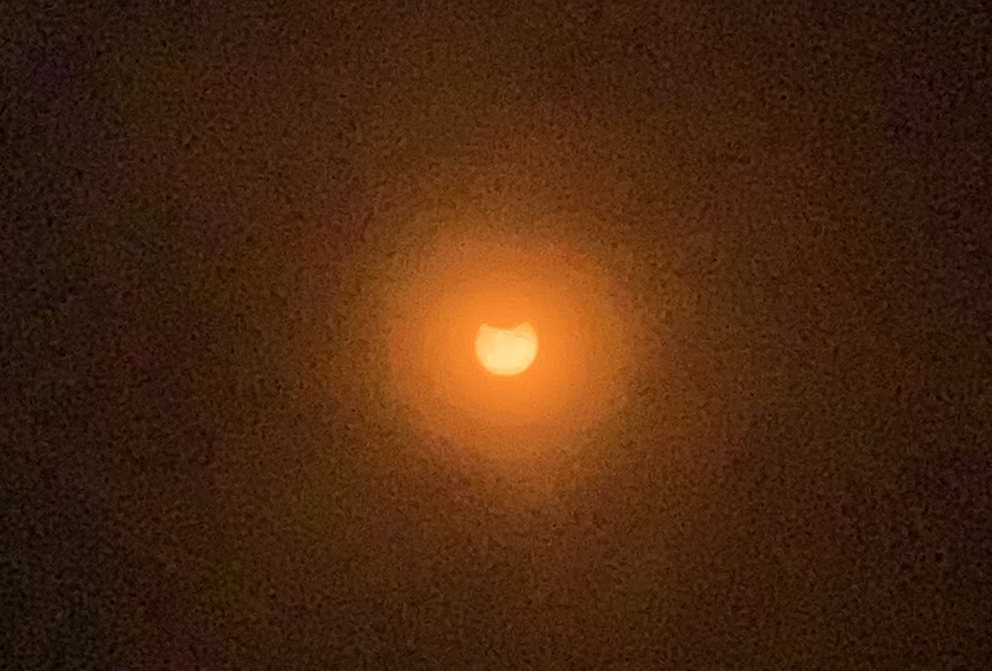Philadelphia
Total Eclipse Of The Art
by | Apr 9, 2024 10:17 am
Post a Comment | E-mail the Author
Posted to: Visual Art , Magic , Festival

M Solivan Photo
Art, albeit shitty (but a better photo than I could get) ...

Nora Grace-Flood Photo
... as compared to a permanent sculpture that served as artistic guidance to Monday's show.
Eclipse Viewing
The Woodlands
April 8, 2024
The Woodlands in West Philly looked picturesque under the half-baked sun Monday afternoon, with picnic blankets, magnolia leaves, and bicycles strewn across the historic lawns as neighbors sought out their personal vision of a rare celestial show: the solar eclipse.
They came expecting a cosmic spectacle. As an arts reviewer, I came looking for an answer to a question: Could an eclipse count as art?

Nora Grace-Flood Photo
A quick iPhone shutter of the scene in front of me: Am I... like everyone on Instagram ... an artist?
With folks laying out in beach chairs wearing what resembled 3D-glasses, I figured the phenomenon of nature would be comparable to at least an IMAX movie experience. And free!
Upon entering The Woodlands, a 54-acre landscape featuring an 18th-century English garden and 19th-century cemetery, I was struck not by the sky, but by the artful appearance of those gathered beneath it. The scene in front of me could have inspired Georges Seurat’s 1884 painting “A Sunday on La Grande Jatte,” I thought.
The event organizers blasted playlists showcasing the songs which the sun had in some way inspired — Bill Withers’ “Ain’t No Sunshine,” Donovan’s “Sunshine Superman.” A librarian was scheduled to perform story hour for the kids in attendance. The music and tale telling certainly imbued the event with an arts theme — but those gathered had their gazes centered on only one thing: the sky we so easily overlook each day.
The sunglassed spectators reacted as though the sun and moon were opponents in Philly’s recent WrestleMania tournament, cheering each time singular rays of sunshine survived the gray overcast and beamed down hope of a pathway through which to view the faux collision.
I asked some of the people watching the sky: Could the clammy clouds, the special event taking place behind them, and the bucolic army of shielded eyes and headstones be art unto themselves?
“Uh, no,” a local groundskeeper responded to my question. “I’m sure it will inspire many artists. But art requires a human.”
“Wait, actually, elephants paint or whatever,” she backtracked. “I guess art requires creation.”
What if God is the creator? I countered. Only to receive shaded glances of suspicion in return.
“No,” an architecture student named Ebbi, too, answered my question. “It’s a force of nature — it’s greater than art!”
A law student named Robby was more open to the idea.
“Yeah, it’s art,” he said. The eclipse, in particular, he pointed out, is like the clearing of an astrological canvass. The moon in effect erases the sun, he said. Similarly, he said, the new moon scheduled for the same night — meaning total darkness — could be considered the creation of “a brand new canvas,” a global reset for the Zodiac-conscious to capitalize upon in the name of reflection and growth.
That seemed more like the definition of a metaphor to me. But I’d take it.
All of a sudden science — or art, or whatever this event was (a symbol of expected repentance? a political decoy? any other totally unconvinving conspiracy?) — interrupted. The audience roared as dozens of people donned their glasses and glanced up at the sky. Thanks to human creation — those black polymer lenses — we were all able to see a shared and particular vision, before extracting our own meanings from the moment.
I stole a moment away from the sky to look once again at the acres of people smiling up at the sun. While many were trying to get photos of what would soon be a memory, most chose to simply enjoy the brief show. Collectively, it looked as though the crew were succumbing to the sun and moon as their own respective artistes — either posing for a photo to be taken by those actors, or, for once, paying full attention to the actors’ partial, but wholehearted, performance.
It all depended on how I decided to interpret the symbiosis. Was I not arts reviewer, but artist, generating a vision within my own head to be observed only internally? And was every member of the crowd, whether those with colanders in hand or those scoffing at my pretentious questions, an artist unto themself? Maybe the organizers were the artists of a party that invited Philadelphians to see the sun in a certain light.
Or maybe the moment was a banishment of the kind of ego I often fear has eclipsed the real meaning of art. Instead of assigning everyone a title of artist, perhaps we could all accept our part in an artwork of collective and ongoing creation and skip the credits.
It reminded me of a specific gravestone I had admired as both gaudy and humble when I first entered the cemetery: A pointed, ten-foot high statue engraved with only the word “Mother.”
As I headed out of the cemetery, looking at blurry snapshots — or, art? — that my friend, M, had captured of the eclipse (pictured at the top of this story), I took one last shot of my own to elicit a response to my question.
I ran up to an elementary school student named Oscar and asked him what he thought of the show. Was that art? I inquired.
“No!” he said. He showed me his sketchbook. Inside was a drawing of a rainbow rectangle on wheels.
“Art!” he declared.
How, I asked, did he interpret this particular piece of crayon craft?
“It’s a monster truck!”

The best work of art produced by a human in The Woodlands Monday: Monster Truck, crayon on paper, 2024.